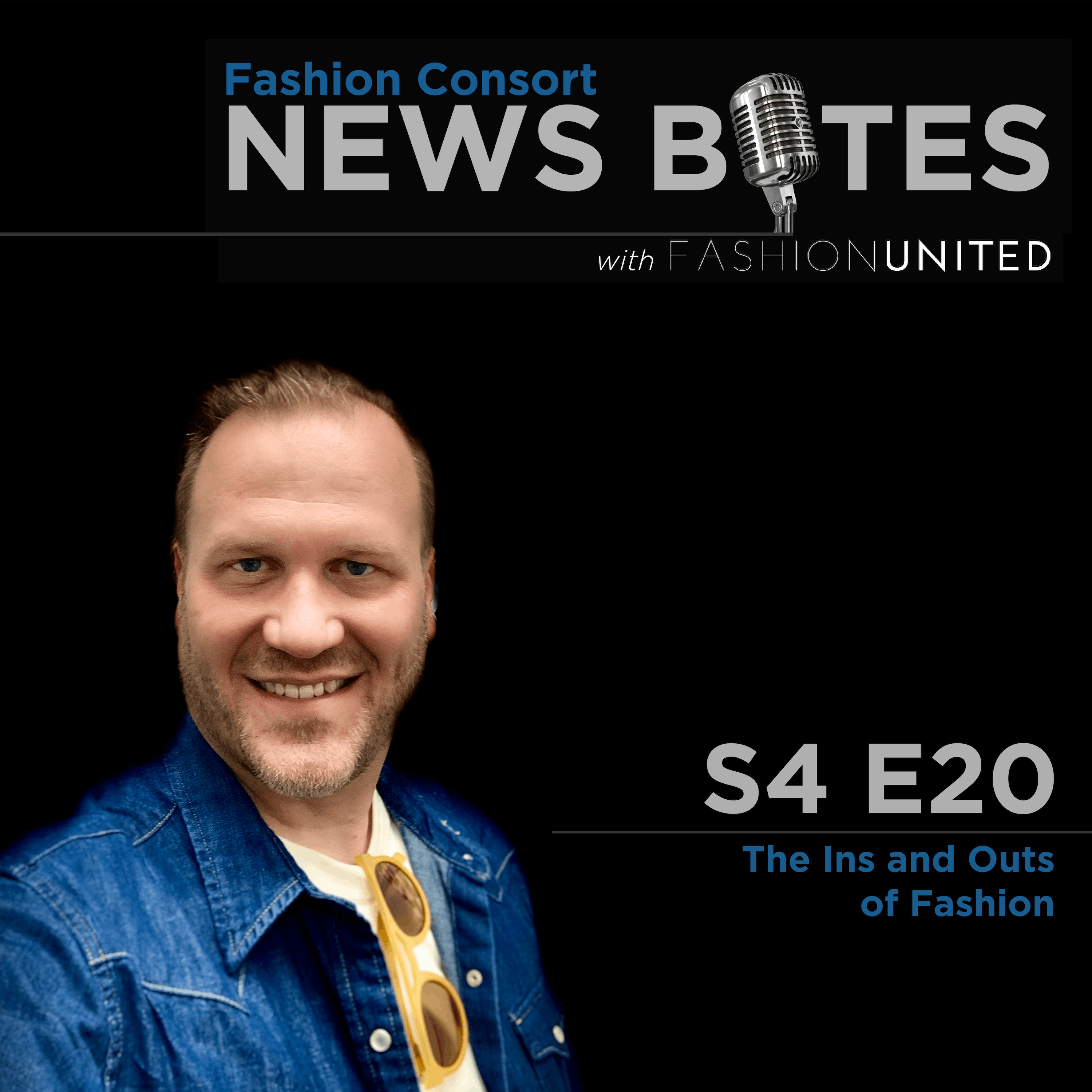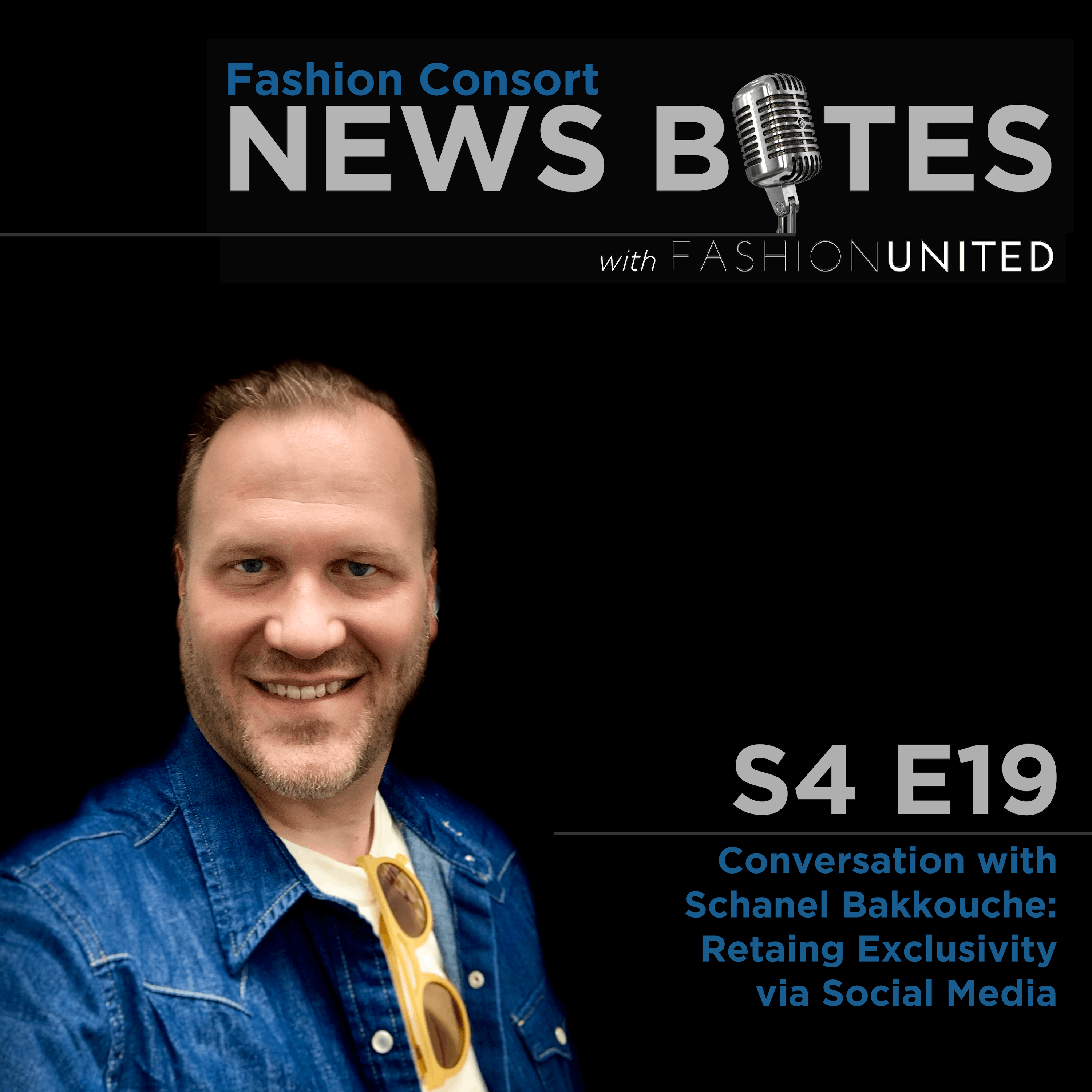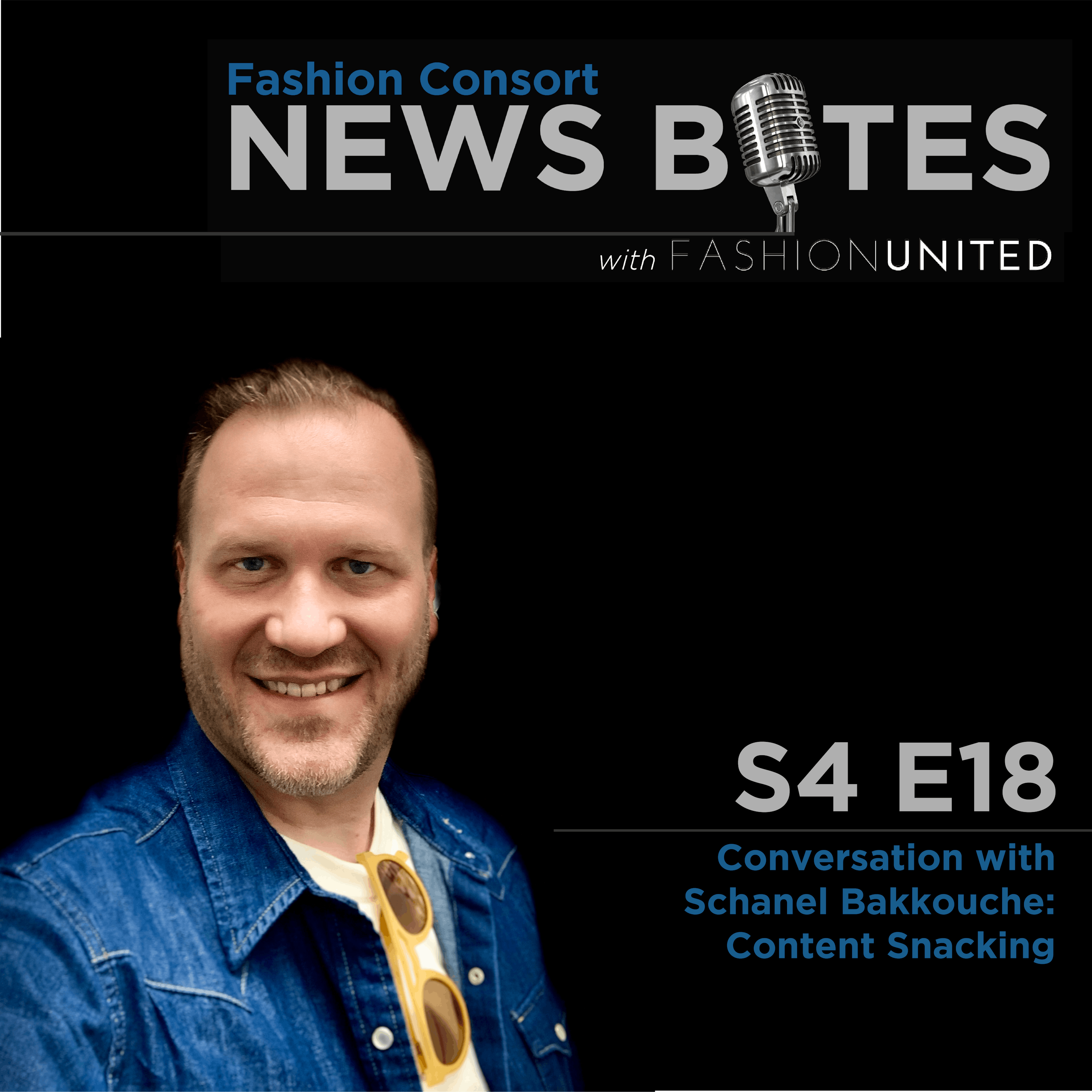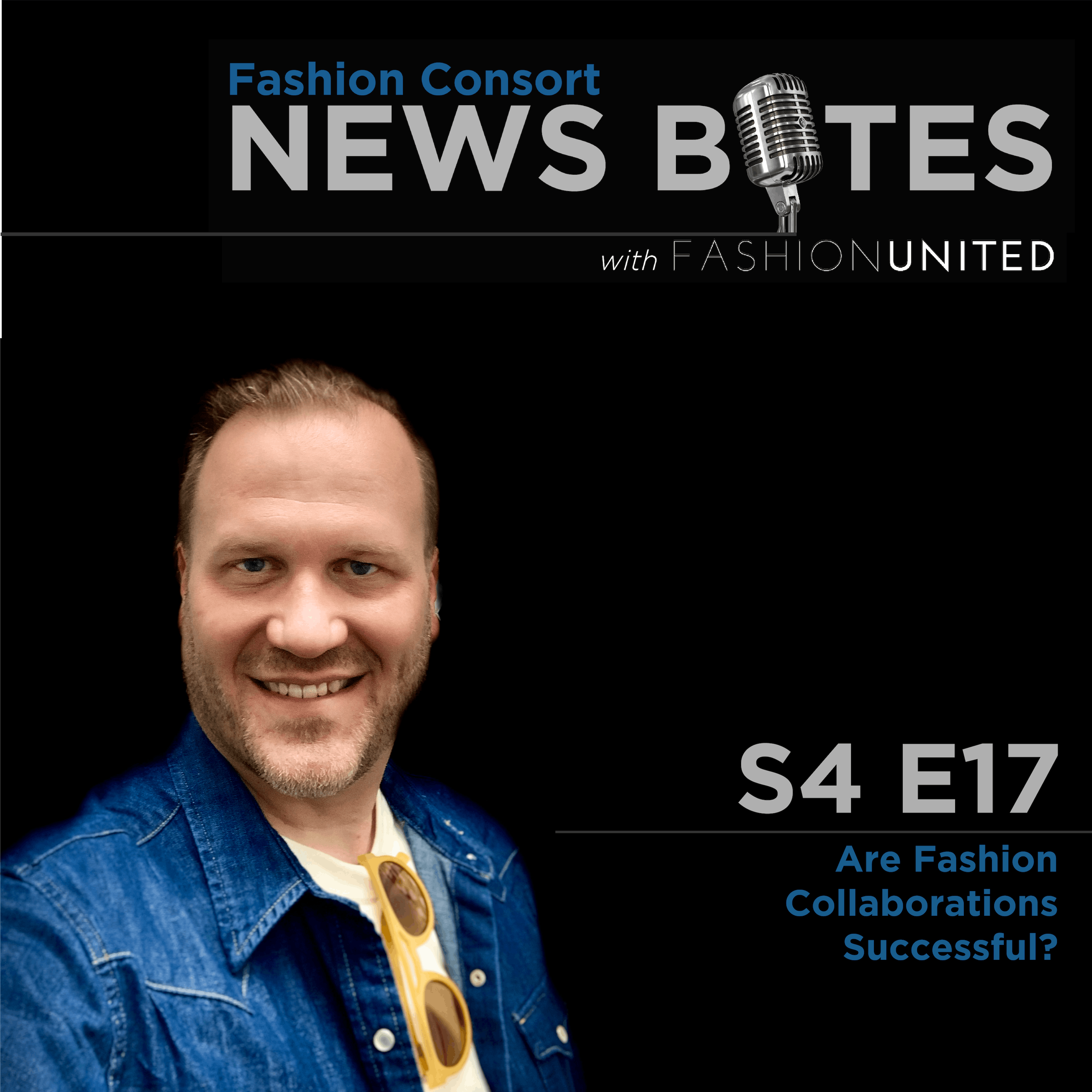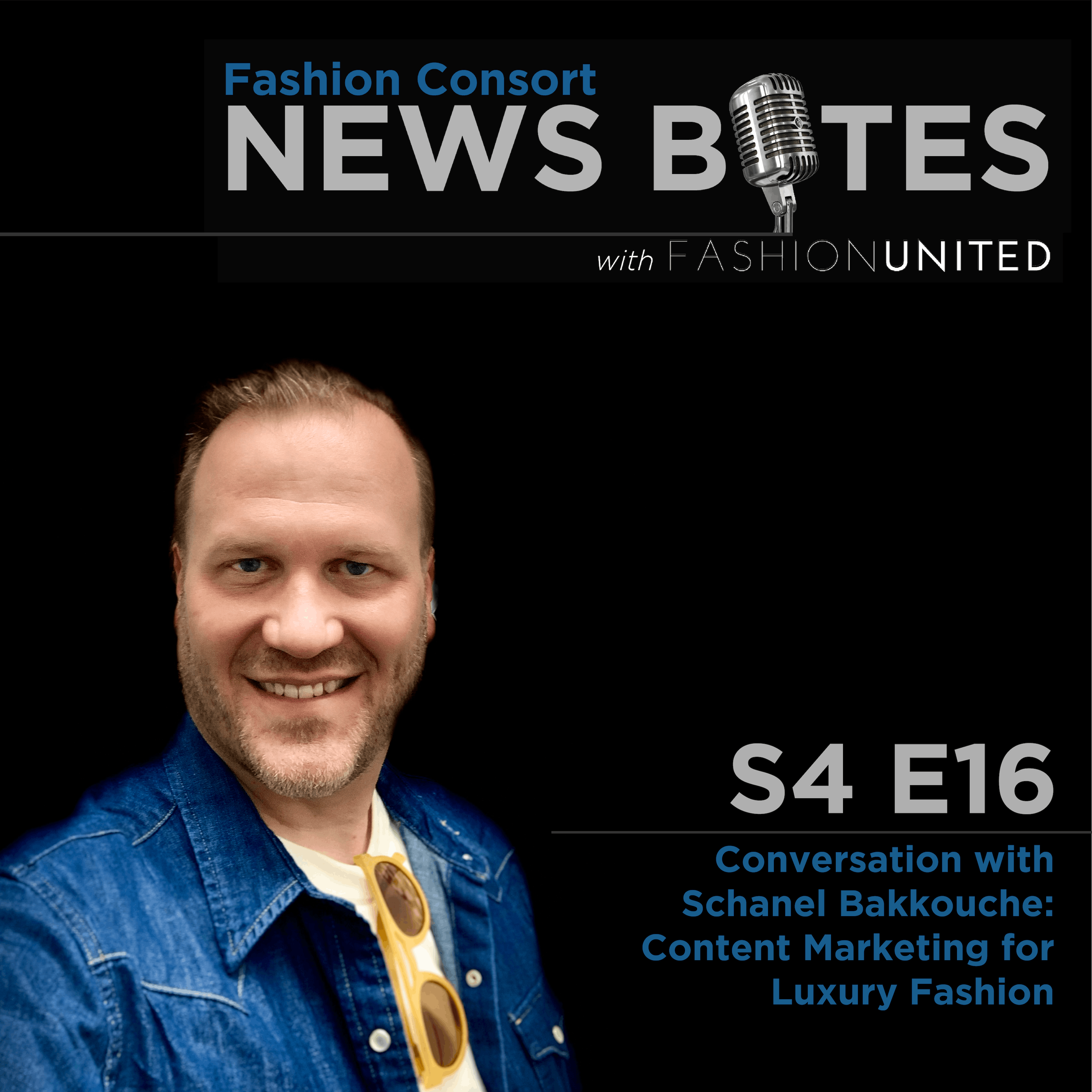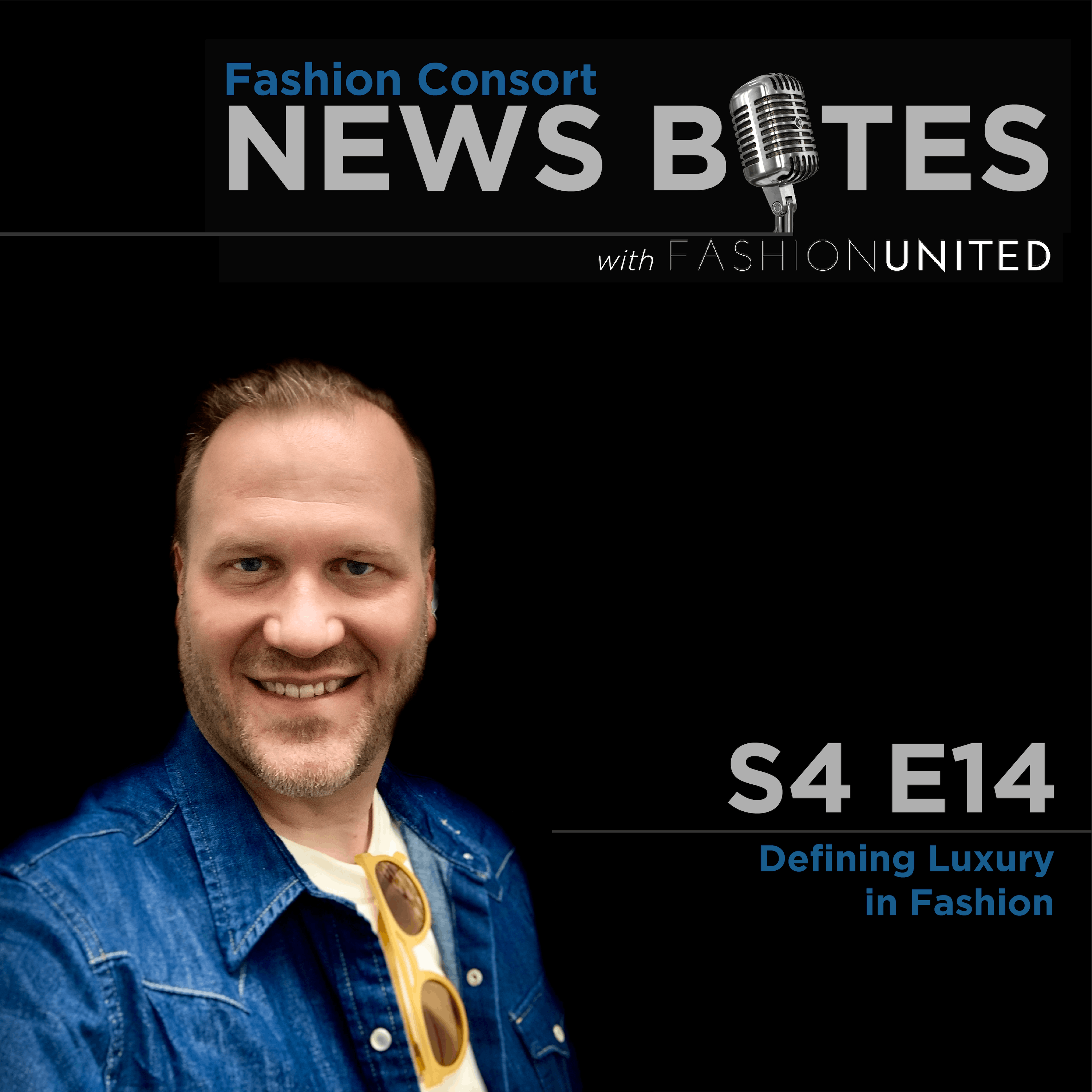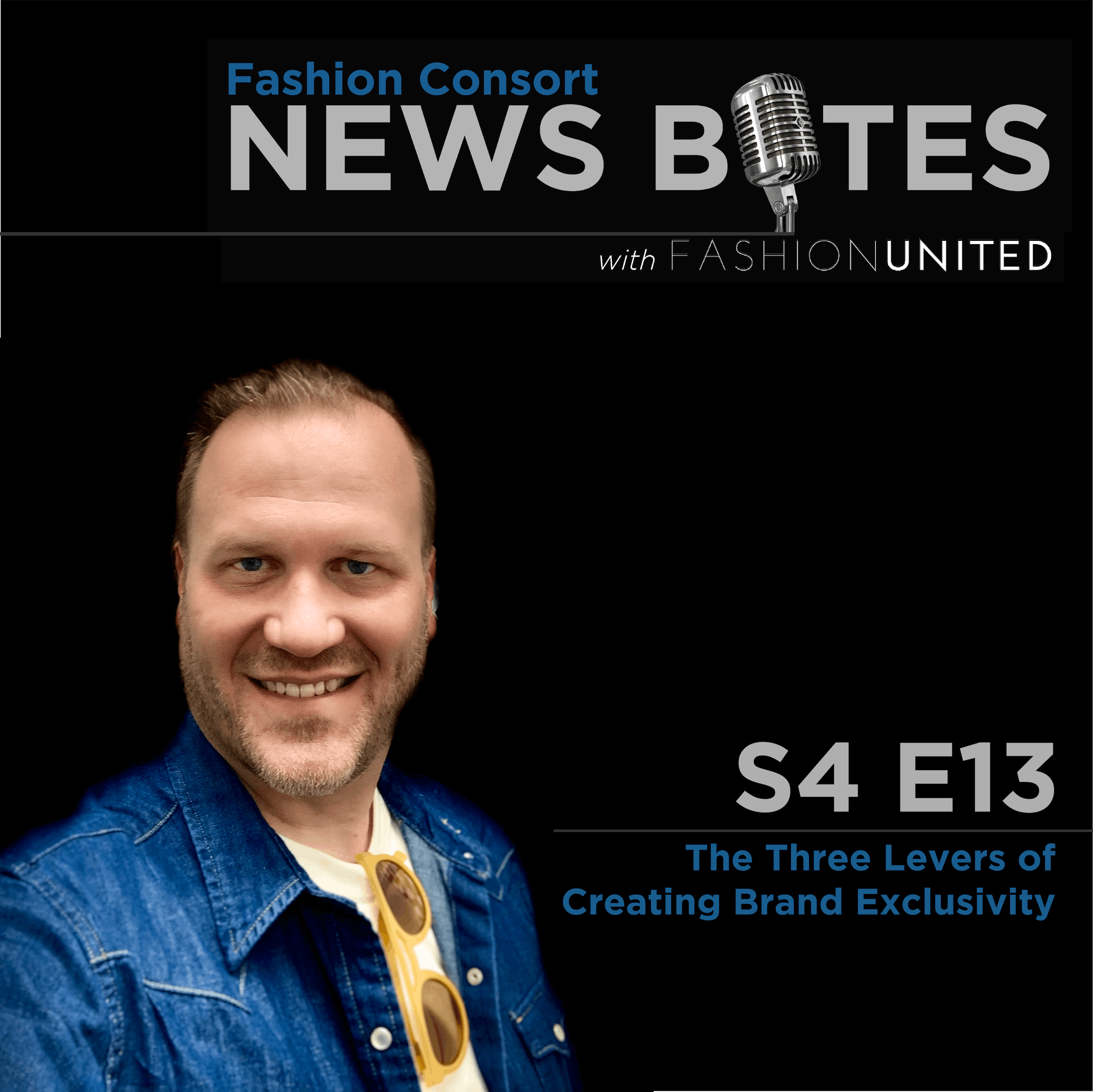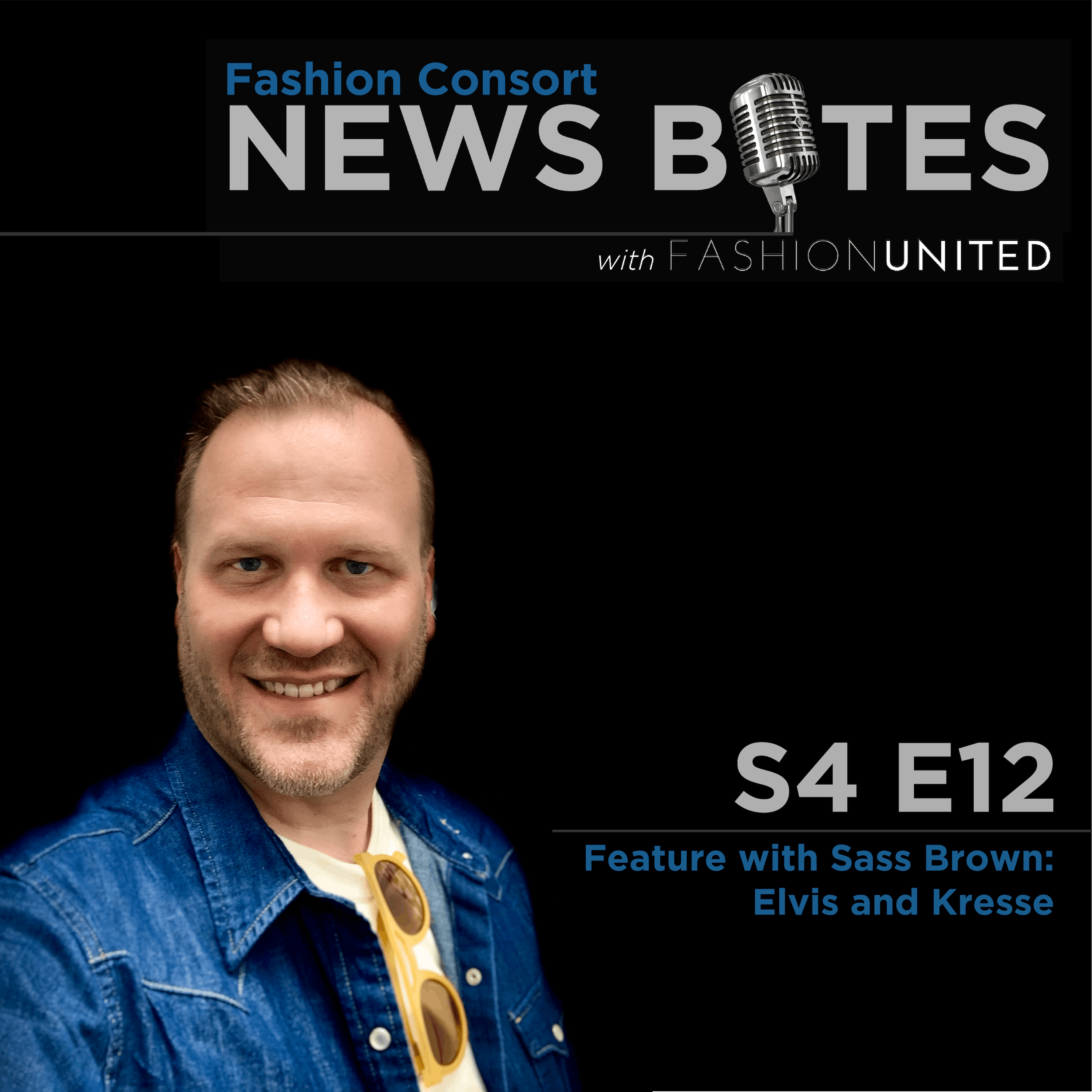Discover Fashion Consort News Bytes
Fashion Consort News Bytes

Fashion Consort News Bytes
Author: Fashion Consort / Joshua Williams
Subscribed: 9Played: 54Subscribe
Share
© 2020 Fashion Consort
Description
A unique, short-format podcast that features insights and perspectives on breaking news and current issues, all focused on the multi-faceted business that is fashion. News Bytes is written by Joshua Williams, produced by Fashion Consort and distributed in partnership with FashionUnited, your trusted global network for fashion news, business intelligence and jobs.
77 Episodes
Reverse
Fashion by definition, is the style or styles worn by the majority of a population at any given time. In other words, whatever most people are wearing right now—a particular, color, pattern, cut or silhouette—is “in fashion,” “in style,” “a la mode.”
Contrary to popular parlance then, fashion is more about fitting in than standing out. It emphasizes group identity, highlighting those groups who wield the most power, or social significance, in the moment. Fashion underscores and externalizes the cultural zeitgeist. And by recognizing what is “in fashion” companies are able to best engage their audience and make a profit.
It seems then that fashion companies should simply be keen observers of the present in order to ensure their ongoing viability. And yet, it’s not quite so simple in an industry where determining what to produce often begins two years before a product arrives. This requires companies then to be constantly ahead of the curve in terms of potential societal trends, in order to deliver appropriate styles. Experts in trend analysis help to facilitate this process—and have become highly sophisticated at mining data to do so--albeit still victim to global health pandemics and Mother Nature. But there is another interesting tool at play—and that is the role of marketing in selling a particular trend. It starts in the business-to-business space—mills selling brands what fabrics they determine will be “in style,” brands then selling retail buyers on the clothes made from these fabrics at trade shows or on the runway, and then retailers selling customers on these same looks. In short, it’s the fashion industry, at large, that sells society on what will be “in fashion.”
For the full transcript, visit: FCNewsBytes.com
Learn more about your ad choices. Visit podcastchoices.com/adchoices
Joshua Williams: Luxury brands are increasingly under stress to expand their market beyond their typical customer base. And in some cases, many brands have been effective, but in other cases, it's alienated the core customer. So, my question for you, Schanel, is can luxury brands retain their exclusivity, notwithstanding the consistency required around digital content distribution.
Schanel Bakkouche: Thank you for having me again. Social platforms characterized by their mass appeal, accessibility, and availability, contradict the very concept of luxury. Obviously, if we think exclusivity of brand, we can think of iconic items from renowned luxury brands; and not everyone owns them. This exclusivity helps luxury brands to maintain their stature: known by all, but paradoxically consumed by a few.
I would mention a few points that are very important. First would be apply the personal touch and stay more authentic. Too often luxury brands will use one generic message.
Then another point that it's very important is use consumer data. I think that customer data needs to be used to gain insight into what customer browse and add to their shopping cart, the offers that resonate with them and they respond to. By using signals such as purchasing behavior, interest, context, and location, luxury brands can make consumer feel that the communication are explicitly tailored to them, to receive personal attention, not to be addressed as a member of a broader audience. You know, this mindset can help luxury brands approach content and service in more meaningful ways.
The other point would be experience. Obviously social media platforms are taking steps to embed the entire shopping journey from discovery to checkout. So, incorporating live streaming sales, integrated product catalog, and now even AR. So, the experience is very crucial point here again, to keep the exclusivity of luxury brands.
For the full transcript, visit: FCNewsBytes.com
Learn more about your ad choices. Visit podcastchoices.com/adchoices
Welcome back Schanel. It's so nice to have you. What is content snacking?
Schanel Bakkouche: Yes, of course. So, we all love snacks, right? So they can never compare to a lavish spread, but the instant gratification that snacks give is undeniable. It's the same with the way we consume content.
If we take today Twitter and I think Twitter is very good example, who would have thought, a few years ago, that this just 140 character medium of expression will change the way we communicate with each other. I feel like, the discipline of word limits imposed on Twitter user has saved us from rambling often found on the internet. And which actually made it even a better tool today and even a more relevant tool.
Joshua Williams: And you're absolutely right about Twitter in the sense that in many ways it's easier to consume. It comes in much more curated means. What does that mean for a luxury brand? How do they create strategies around content snacking, when usually their focus is on telling a much more lavish, as you said, story or narrative about their brand?
Schanel Bakkouche: I mean, I would say that due to the fact that we are living in a time where visibility matters most, the flip side is that competition and growth within the luxury industry here is forcing brands to find new ways of developing creative brand awareness. I think this is where, like, you know, content snacking means a lot for brands, to develop their marketing strategy because they just need to communicate differently.
For the full transcript, visit: FCNewsBytes.com
Learn more about your ad choices. Visit podcastchoices.com/adchoices
On the surface, fashion collaborations might seem like an exciting way to generate new business and overall sales performance. Whether the collaboration is relatively obvious, such as Gucci and Adidas, or more surprising, such as Crocs and Balenciaga or Alexander McQueen and Target, they certainly create interest and engagement, typically in terms of generating new customers. And it’s relatively clear that in terms of luxury brands collaborating with more mass brands, the goal is to connect with the aspirational customer.
Dig below the surface, and the efficacy of these collaborations, and their ability to truly capture new customers and increase sales, is dubious at best, especially for the luxury brand. It’s not like the typical Target customer all of the sudden shopped at the McQueen boutique, paying $1000s more for an item that was under $100 at Target. In fact, for many brands, these high-profile collaborations often raise a bar that cannot be easily or consistently recreated—forcing luxury brands to chase after their business, which is hardly the modus operandi of luxury brands and their quest for exclusivity. In fact, often these collaborations are a signal that all is not well with a brand—and that without relying on the affinity or success of another more accessible brand—they are not meeting their numbers.
Learn more about your ad choices. Visit podcastchoices.com/adchoices
Hello, Schanel. It's so wonderful to have you.
We're talking about content marketing and how it shifted over the past few years, specifically in the luxury space. Content marketing is a buzz word in the marketing world, but what does it actually mean?
Schanel Bakkouche: First, thank you for having me.
Content marketing or brand related content, is which consumers in all case or luxury consumers, actually choose to engage. So it has a value for the audience first, whether entertainment, information, or other value; and the brands second. Content can live in marketing and media channels; [00:01:00]it's not a channel itself, I would say. Content can be a spoke or a hub. It can be distributed through media or part of a destination. Importantly content is a means of engagement with current and prospective customer and give the luxury brands it's own voice.
Joshua Williams: Very interesting. So, what is the role then of content marketing for luxury brands specifically?
Schanel Bakkouche: For luxury brands, the chief value of content marketing lies in its ability to reel in, persuade and evangelize the most discerning audience in the language and elevated aesthetic that is particular to luxury.
For the full transcript, visit: FCNewsBytes.com
Learn more about your ad choices. Visit podcastchoices.com/adchoices
Joshua Williams: Hello, Sass, welcome back. And who are we going to feature this month?
Sass Brown: The IOU Project.
Joshua Williams: Ah, the IOU Project. I know they're based in Madrid. Spain. Can you tell us a little bit about them and their founder?
Sass Brown: Absolutely. The founder is Kevita Parmar. She works predominantly with hand loomed madras cotton out of India. If you're familiar with the madras cotton, it's quite distinct, they're often candy colored checks and they're quite different from weaver to weaver. Each one is quite unique. And so what she does, she works with locally grown cotton from that region that is then hand-woven. So we're talking about a fabric that has literally no carbon footprint to begin with. But moreover, he really honors the makers, whether it's the maker of the garment or the weaver of the fabric as a truly vital component of her value chain of the garment. And as equal in terms of standing as the designer or the customer.
So it's a very flat, democratic program or company, if you like. It's not hierarchical, where the designers at the top and the makers at the bottom. And so the website is fabulous. First of all, it's beautiful. It's very visually presented. And it features each of the garments, the makers of the garment. So you can dig into each garment and see who the weaver was. You can read a little bit about them. You can see who the maker was, the producer of the garment, the garment manufacturer, maybe watch a video. She specializes in small, little workshops in Portugal and Spain. And the fabric, as I said in India.
So it's very much about authorship and provenance and respect for all of the components that go into making the garment and giving a face and a voice to each of those people, who are normally so hidden from the customer.
For the full transcript, visit: FCNewsBytes.com
Learn more about your ad choices. Visit podcastchoices.com/adchoices
Ask an average consumer what luxury fashion is, and they’ll likely respond with well-known brand names such as Gucci, Yves St. Laurent and Louis Vuitton. But what makes these brands luxury? Well, that question is a bit harder to answer and elicits a wider range of responses: quality, craftsmanship, high price, exclusive, made in France, made in Italy, heritage…and the list goes on. In fact, fashion luxury isn’t any one thing, and often lives more as a fluid concept in the abstract, than something that can be quantified or formalized.
However, if we shift the context from adjective to noun, we find some additional clarity. A luxury is something that a customer doesn’t need, but chooses to buy nonetheless, to enjoy and find pleasure in. And while that may no longer be purchasing fine silver that requires polishing, or cashmere that necessitates brushing (especially when we don’t have a wait staff to do these things for us anymore), it certainly can be applied to purchasing clothing that we don’t need, but want. This might be purchasing a $20 black tee at Zara to add to an overflowing closet, or buying a $750 black Balenciaga logo tee-shirt simply because we can afford it. The latter is certainly not defined by its quality, craftsmanship, exclusivity, etc.—rather it’s brand name and high price. And thus, it stands out as something a bit different than our traditional understanding of luxury fashion. Perhaps a more apt term for it is mass luxury, or even fast luxury, more connected to its fast fashion counterpart in terms of mass production and marketing, than not. And it’s an approach that is gaining traction, the more digitized and globalized we’ve become, and the more growth traditional luxury brands seek, especially in Asia.
For the full transcript, visit: FCNewsBytes.com
Learn more about your ad choices. Visit podcastchoices.com/adchoices
Chanel’s recent announcement to precipitously inflate prices on their bags, and limit quantities customers can purchase, has hit the headlines, with some questions about how the luxury fashion industry continues to grow despite overall economic inflation. And in this case, considering the level of the price change, Chanel is not raising its prices to combat higher costs, but rather to become more exclusive, to break away from other luxury brands.
Luxury brands have always had three clear levers in which to build exclusivity.
For the full transcript, visit: FCNewsBytes.com
Learn more about your ad choices. Visit podcastchoices.com/adchoices
Joshua Williams: Hello, Sass. Welcome back. Who are we featuring this month?
Sass Brown: We're featuring Elvis and Kresse.
Joshua Williams: Ah, the duo out of the UK who started with a very specific fabrication. Can you tell us a little bit about that?
Sass Brown: They did indeed. They started with decommissioned fire hoses, so very particular resource that of course, much like military equipment gets decommissioned quite quickly, because you're talking about health and safety here. So you don't want to a fire hose with a hole in it or a worn patch, so they get decommissioned quite quickly and there's very hard-wearing resource material. They make a whole line of accessories; bags, everything from little small wallets, all the way up to a great big weekend bags and totes out of these seamed together, decommissioned fire hoses.
And they have this fantastic sort of patina and wear on them from use. Of course, the whole story of where they came from and their function prior to being a bag. But they're really slick, beautiful bags and purses and wallets and totes that they make out of this material. They're really lovely.
For the full transcript, visit: FCNewsBytes.com
Learn more about your ad choices. Visit podcastchoices.com/adchoices
Fashion education is ripe for change. As we emerge from the Covid-19 pandemic, it will require a much more flexible, multi-disciplinary, omni-channel approach, that is more in line with the shifts happening in the industry, especially in terms of digital tools and access. Institutions will need to rethink educational content and delivery to rebalance a liberal arts approach with more interdisciplinary vocational skills that are moored in a digital economy. And student tuition will need to be recalibrated to be more in line with post graduation expectations and salaries.
Universities will need to continue to build their faculty base, bridging the gap between industry and the academy and facilitating more crossover between both. This will require higher paying jobs that are more in consort with industry pay in order to attract top talent.
Businesses will need to incorporate more nuanced learning opportunities into their own employee offerings, rather than relying on external degree programs. This might include offering “bridge curricula” for post-graduates, partnering with universities to build curriculum and programming, rethinking internship programs and even offering paid apprenticeship programs. In turn, these efforts will help provide more opportunities for a company to teach hyper-focused skills as well as innovate. Studies also show that employees that have access to learning through their employers are most likely to stay at a company.
For the full transcript, visit: FCNewsBytes.com
Learn more about your ad choices. Visit podcastchoices.com/adchoices
Much like retail has had to evolve to meet the demands of shopping across physical and digital channels, education is also being forced to evolve. Contemporary students require new ways of learning, both in terms of content structure and delivery, that build more on the shifts in media than traditional education--leaving academic institutions largely unable to meet demands without reliance on external partnerships with ed-tech companies.
The current university model is heavily reliant on an in-person, on campus experience. Not only is this how it’s “been done” for more than a century, it also provides institutions with multiplicitous profit centers from cafeterias, dorms, sports events and more. When the Covid-19 pandemic hit, universities weren’t able to bring students on campus, meaning profit was no longer coming from these sources--and in fact, had become a liability in the form of empty classrooms and dorms. It is no wonder that these institution’s first priority then was to get students back in person. These preparations began in earnest once a shift to online learning was facilitated in spring 2020. By fall 2021, most universities were back open for business despite the Delta variant.
In all of this, the stark contrast was that university development over the past 50 years was largely focused on building new buildings and expanding the campus footprint, while the rest of the world was turning more digital. Universities were putting very little thought (and budgets) into the development of new digital learning technologies, modalities and support systems, including the purchase of video equipment, recording studios and even digital pedagogy.
For the full transcript, visit: FCNewsBytes.com
Learn more about your ad choices. Visit podcastchoices.com/adchoices
In a recent New York Magazine article, author William Deresiewicz stated, “For educational institutions, master’s programs are cash cows since their students get far less financial aid than undergraduates. For students, the master’s program responds to a specific need: American workers are competing more and more with those around the world, and the more college graduates there are, the more you need to find a way to distinguish yourself from the mass.”
This is particularly true when it comes to vocational studies, such as fashion, where master’s programs have proliferated from a handful across the U.S., to a handful of offerings from hundreds of universities. For example, Parsons School of Design in New York City now offers twenty master’s programs, including MFAs, MAs, MSs and MPSs. The MPS, or Masters of Professional Studies, is a relatively new moniker that is given to vocation-specific education, such as Fashion Management. It isn’t an MBA, in that it lacks the focus on finances and statistics, and it’s focus is on one industry only--fashion.
The cost of these programs, especially by high-profile universities from Columbia to RISD, are very high, often over $50,000 per year. And that adds up in a 2 or 3 year program. And while data suggests that students who graduate with a masters do make more than their counterparts, these high costs make a graduate program very risky, saddling students with debt that may take years to pay off.
For the full transcript, visit: FCNewsBytes.com
Learn more about your ad choices. Visit podcastchoices.com/adchoices
Joshua Williams: Each month on NewsBytes, we feature a fashion brand that approaches business differently and innovatively or operates outside of the main fashion systems and capitals. I'm with Sass Brown, an expert in ethical fashion, sustainability and craftsmanship. She is the former Dean of Art and Design at the Fashion Institute of Technology and the founding Dean at Dubai Institute of Design and Innovation.
Joshua Williams: Hello, Sass. Who are we featuring this month?
Ah, Re;code, based in Korea. Can you tell us a little bit about them and what makes them unique.
Sass Brown: Yeah, they are a really fabulous company. And they work effectively with upcycled materials, revalued, discarded, and unused materials.
They're part of a larger conglomerate called Kolon Industries. They're a small subsidiary of it. And so they utilize the dead stock and the wasted materials from the other labels that are produced under the same umbrella company. So they use dead stock from their own warehouse. They use military waste. They use industrial waste, things like car seat covers and car airbags and seat belts and things like that. So, they do have some quite unique sources for their materials.
And they do use also post-consumer, or finished garments anyway. So they dismantle them and reconstruct and redesign them. You can see it quite clearly when you look at their designs. You'll often see half a jacket front, which is inside out, or, you see the pocket details or a sweater that's been applicated on top of a sweater up front that's been appliqued on top of a shirt, for example. So you can see the reconstruction quite clearly in their aesthetic.
Joshua Williams: How driven are they by a particular visual aesthetic or do they let the waste, the consumer waste that you're talking about sort of drive what that vision becomes?
Sass Brown: I think it's a bit of both.
They have a very distinct aesthetic. You can pretty much tell a Re;code piece. They have a way of deconstructing and reconstructing their garments that's quite specific and quite unique and various aesthetically pleasing.
For the full transcript, visit: FCNewsBytes.com
Learn more about your ad choices. Visit podcastchoices.com/adchoices
In the US, the GI Bill was passed to help World War II veterans acclimate back into civilian life. One of the key components of this bill was to provide servicemen with access to an affordable college education. This had the effect of greatly increasing the amount of people with a college degree from the 1950s on, ultimately shifting education from a privilege of the rich, to a rite of passage for most Americans. And this access to education had the effect of increasing the middle class, while also shifting the economy from blue collar to white collar jobs.
However, as the economy shifted away from the factory to the office in the 1970s and 80s, blue collar jobs also became less desirable. This required companies to offshore their factories--and had the added benefit of cheaper labor, with less governmental regulation. By the 1990s, this meant that most fashion related production--textiles and apparel--no longer happened in the U.S. or in Europe; it had shifted primarily to China and India and then further into southeast Asia. This shift in production brought a wave of money to these countries, effectively shifting their economies and facilitating the birth of their own middle classes, as well as the fortunes of many.
In time, the new business owners of China and India and their children and grandchildren became the fastest growing consumer segment in the world. Not only were they buying more things, they were also going to college in higher numbers. For those that could afford it, attending top schools in London, Paris and New York--especially to study fashion--was the primary objective. These schools were seen as the penultimate in design and business education--and offered well-known brand names on resumes.
For the full transcript, visit: FCNewsBytes.com
Learn more about your ad choices. Visit podcastchoices.com/adchoices
Due to the specialized nature of retail and fashion, training “on the job” has always been an integral part of the industry. In some cases, this learning was informal, particularly in family run businesses, but it was also formal through apprenticeships, where young people were hired to learn a trade at an atelier with the goal for them to become full-time employees. These individual apprenticeships also led to internal certification programs--especially at larger retailers--wherein this learning could be provided at scale, albeit still at a local level. For example, Neiman Marcus’ training program in Dallas or Macy’s training program in New York City. However, as fashion became more corporatized and globalized, these informal and formal types of learning largely disappeared, or shifted to an HR function, leaving a gap in the employee training process.
Concurrent with the shift of fashion education into degree-focused programs was the growth of internships, wherein companies would collaborate with academic institutions to hire non-paid workers to do low level jobs--with the promise that students would get real-world experience and training, and possibly a job at the end of their internship. In theory, this system seemed to benefit all students, especially if an internship was built into a program. But in practice, internships have largely favored the economically advantaged, has normalized unpaid work, and often doesn’t lead to a full time job.
First, internships have largely favored the economically advantaged for a few reasons. One, students who have more economic means have a stronger network--often through their parents--to access internships in general, and better internships more specifically. Two, because internships are tied to credits (as a way to legalize unpaid work), students are essentially paying for their own internship. So students must make a decision between paying for an internship, or paying for another elective, not to increase their base tuition. Those with economic means can more easily do both. And three, students often must work in order to pay for their college experience. Doing an internship on top of school and a paying job is almost impossible. And it’s rare that schools will allow a paid job to count as an internship--and if they do, then students are essentially paying to work their own job and not benefitting from additional courses in their major. On top of this, many students will choose schools in areas such as New York City or London to study, in order to access internships. The cost of living and studying in these areas is substantially more than at local universities. The net outcome is that students with means have more opportunities for internships and then jobs upon graduation. And this means that the funnel of incoming employees doesn’t match the diversity of the student population, thus perpetuating systemic racism within the retail and fashion industries.
For the full transcript, visit: FCNewsBytes.com
Learn more about your ad choices. Visit podcastchoices.com/adchoices
Fashion as an academic discipline is relatively new. It’s not to say that people haven’t been researching the intersection of clothing and economics, clothing and psychology, or clothing and culture--to name a few--for quite some time, rather that it hasn't been taken seriously as its own discipline. However, with formalization of fashion as a discipline within the academy, and the growth in graduate level programs, there has been a surge of fashion-specific research both by faculty and students.
And because this research isn’t necessarily tied to a company’s success--meaning that it’s not research being done as part of one’s job, or in service of a client--this has provided more opportunity to research without a required or expected outcome. In short, it has allowed for more direct critique of the fashion system. It’s no surprise then, that a correlation can be drawn between the growth of fashion research and a growth of interest in subjects such as sustainability, human rights and EISJ. These topics are consistently in the top five when it comes to student research.
Over time, these areas of academic focus have shifted from the institution to the industry, for two reasons: 1) students are graduating with these topics being front and center in their learning and 2) the more educated people become, the more they demand change from companies. However, this process has been slow and highlights the lack of direct collaboration between academia and industry.
For the full transcript, visit: FCNewsBytes.com
Learn more about your ad choices. Visit podcastchoices.com/adchoices
Each month Sass Brown, an expert in ethical fashion, sustainability and craftsmanship, shares a fashion brand that approaches business differently and innovatively or operates outside of the main fashion systems and capitals. Sass is the former Dean of Art and Design at the Fashion Institute of Technology and the founding Dean at Dubai Institute of Design and Innovation.
Christopher Raeburn is a design-led, London-based womenswear, menswear and accessories fashion brand. Christopher works with certified organic materials, recycled polyester, and a lot of surplus materials, particularly military surplus. According to Sass Brown, Christopher’s aesthetic comes from, “a fascination with military materials and something that he's quoted as saying ‘archeological discoveries.’”
The brand dates back to about 2009 and Christopher’s first collection, which was fall winter 2010, was made from decommissioned military wool field jackets and nylon parachutes. Sass points out, “that's an aesthetic that has continued throughout the collection, since that day. It's very technically savvy; it's full of utilitarian details.”But it also includes some whimsy, she says.” This combination of whimsy and the utilitarian makes his designs very recognizable on the streets.
For the full transcript, visit: FCNewsBytes.com
Learn more about your ad choices. Visit podcastchoices.com/adchoices
For many years, the onus of educating employees in the fashion industry was primarily that of the employer. Firstly, the industry relied heavily on women and because higher education was not generally available to them, companies had to train them with the skills they needed to do their jobs. Secondly, most fashion companies were family run businesses and relied on local workers, so the training happened naturally on the job. Thirdly, fashion required specialized skills related to merchandising, buying, production and retailing. And because each company had their own approach or style, companies benefited from training employees according to their particular needs. As companies grew, these programs expanded to be more formal, with the likes of Macy’s offering full training programs and certifications. In fact, early fashion schools such as the Fashion Institute of Technology built their two-year certifications on matriculating students into these types of programs.
While some of these corporate programs persist, their fundamental approach (and need) shifted once fashion education became fully integrated into undergraduate degree programs at universities. The onus for training employees shifted from the employer to the university. To a degree, this helped to provide a more consistent foundation in terms of knowledge and skills. And it provided students with a more 360 degree view of the industry beyond a specific job they were training for, along with better soft skills, such as collaboration and communication. But, it also meant that students were learning less hard skills, creating a chasm between what was learned in college versus what was needed on the job.
For the full transcript, visit: FCNewsBytes.com
Learn more about your ad choices. Visit podcastchoices.com/adchoices
In the mid-1990s, fashion education became more fully integrated into the academy, allowing students of fashion to receive more than vocational training. Their studies in fashion design or fashion merchandising were now combined with a traditional liberal arts or business education, leading to a bachelor’s or baccalaureate degree. This had the effect of formalizing, even legitimizing, fashion as an academic pursuit and a desired career. And with the burgeoning proliferation of fashion content in the media, especially with Project Runway and blogging, followed by smartphones and social media, colleges and universities were quick to realize the profit potential of offering fashion degree programs.
Shifting a fashion education into a more liberal arts setting requires students to take non-fashion courses such as sciences, mathematics, history and so forth, in order to meet accreditation standards. While this ensures a more well-rounded education, it also means less time to focus on fashion related subjects and skills training. For bachelor-level students, this means taking a series of foundational courses, and perhaps an elective or two, without ever having the chance to deep dive, or gain expertise in any one particular area. The goal then becomes on providing a foundation of knowledge and the ability to think critically--the hallmarks of a liberal arts education-- on which students can build, once they enter the industry. While there is certainly value in this approach, it has also led to a wide chasm between what knowledge and actual skills students graduate with, versus what employers expect of them, or need.
For the full transcript, visit: FCNewsBytes.com
Learn more about your ad choices. Visit podcastchoices.com/adchoices
In the mid-1990s, fashion education became more fully integrated into the academy, allowing students of fashion to receive more than vocational training. Their studies in fashion design or fashion merchandising were now combined with a traditional liberal arts or business education, leading to a bachelor’s or baccalaureate degree. This had the effect of formalizing, even legitimizing, fashion as an academic pursuit and a desired career. And with the burgeoning proliferation of fashion content in the media, especially with Project Runway and blogging, followed by smartphones and social media, colleges and universities were quick to realize the profit potential of offering fashion degree programs.
For the full transcript, visit: FCNewsBytes.com
Learn more about your ad choices. Visit podcastchoices.com/adchoices


